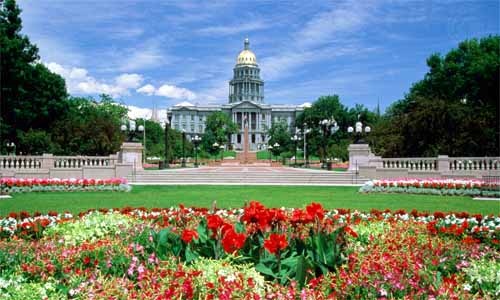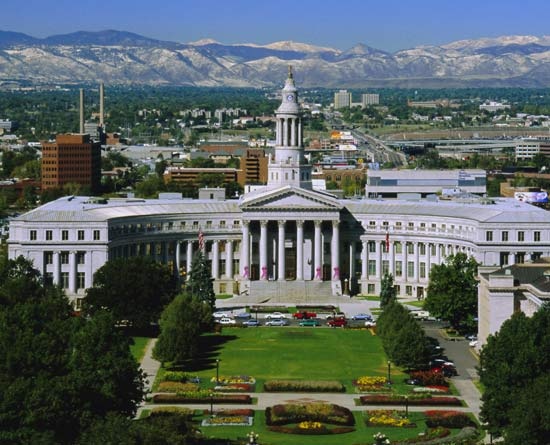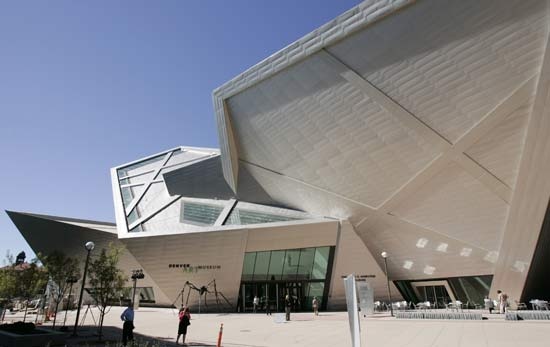Denver
Colorado, United States
Introduction
 city and county, capital of Colorado, U.S., at the western edge of the Great Plains, just east of the Front Range of the Rocky Mountains. The city and county were consolidated as a single administrative unit in 1902. Denver lies at the junction of Cherry Creek and the South Platte River; its elevation (5,280 feet 【1,609 metres】 above sea level at the State Capitol), which gives it the nickname “Mile High City,” and a mild, sunny, dry climate are distinctive characteristics. Metropolitan growth after World War II created a ring of suburban communities, including Arvada, Aurora, Brighton, Broomfield, Cherry Hills Village, Englewood, Lakewood, Littleton, Northglenn, Thornton, Westminster, and Wheat Ridge; Golden, about 12 miles (19 km) west of Denver, and Boulder, about 25 miles (40 km) northwest, are also part of the metropolitan region. Greater Denver is at the centre of a string of urban areas that stretches along the Front Range from Fort Collins in the north to Pueblo in the south.
city and county, capital of Colorado, U.S., at the western edge of the Great Plains, just east of the Front Range of the Rocky Mountains. The city and county were consolidated as a single administrative unit in 1902. Denver lies at the junction of Cherry Creek and the South Platte River; its elevation (5,280 feet 【1,609 metres】 above sea level at the State Capitol), which gives it the nickname “Mile High City,” and a mild, sunny, dry climate are distinctive characteristics. Metropolitan growth after World War II created a ring of suburban communities, including Arvada, Aurora, Brighton, Broomfield, Cherry Hills Village, Englewood, Lakewood, Littleton, Northglenn, Thornton, Westminster, and Wheat Ridge; Golden, about 12 miles (19 km) west of Denver, and Boulder, about 25 miles (40 km) northwest, are also part of the metropolitan region. Greater Denver is at the centre of a string of urban areas that stretches along the Front Range from Fort Collins in the north to Pueblo in the south.Inc. 1885. Area city, 155 square miles (401 square km). Pop. (2000) city, 554,636; Denver-Aurora MSA 2,179,240; (2005 est.) city, 545,198; Denver-Aurora MSA, 2,359,994.
History
The site served as an early stopping place for Arapaho Indians, fur trappers, and traders. With the discovery of gold in June 1858, the rival towns of Auraria and St. Charles were founded on opposite sides of Cherry Creek. The claim of St. Charles was soon jumped by William Larimer, Jr., who in November 1858 renamed it Denver City for James W. Denver, governor of the Kansas Territory, of which the city was then a part. The site grew during the 1859 “Pikes Peak or bust” gold rush. Denver City and Auraria consolidated in 1860; the following year Colorado Territory was established and Denver City became Denver.
The city was devastated by fire in 1863, and a year later a flash flood swept away many buildings, including the city hall. Uprisings by Cheyenne and Arapaho Indians on the plains in the 1860s resulted in their forced removal from Colorado. Denver became the territorial capital in 1867. When the transcontinental railway was built through Wyoming, Denver's citizens organized their own railway, completed in 1870, to connect with the Union Pacific (Union Pacific Railroad Company) at Cheyenne; the Kansas Pacific Railroad reached Denver shortly thereafter. The resulting economic boom increased the population from 4,759 in 1870 to 106,713 in 1890.
During the 1870s and '80s, silver (silver processing) became more important economically than gold. Mining fortunes were created almost overnight, and an opera house was built. This period of opulence ended in 1893 with the crash of the silver markets. Banks failed, smelters shut down, and silver kings became paupers. New gold discoveries helped prevent a major decline, and farming, cattle and sheep ranching, and tourism began to provide a more stable economy. Railroads brought in sugar beets, wheat, cattle, and hogs, and Denver became a food processing centre. This industry was supported by waves of immigrants, including German brewers.
Military activities—defense contractors and other facilities related to the Cold War—contributed to an economic boom after World War II, but most of these activities ended in the 1990s. Another boost came with soaring oil production in the 1970s, and high-rise office buildings were constructed throughout the city. However, Denver's population began declining after reaching a peak in about 1970, and a crash in oil prices in the mid-1980s led to economic bust. Increasing population and the growth of tourism brought back prosperity in the 1990s, the city's population surpassing its 1970 level by 2000.
The contemporary city
The present-day Denver metropolitan area spreads well into the foothills to the west of the city and the high plains surrounding it on the other three sides. In addition, Boulder, home of the main campus of the University of Colorado (Colorado, University of), is now linked to the metropolis by a nearly continuous built-up suburban corridor. People of European descent constitute the majority of Denver's population, but those of Hispanic ancestry (particularly Mexican) comprise an increasing one-third of its residents; a relatively small proportion (about one-tenth) are African Americans, with even smaller numbers of Asians and Native Americans.
The region's rapid growth since 1950 has increased the strain on its infrastructure, especially water and transportation systems. The bulk of Denver's water supply comes from spring snowmelt in the mountains that is stored in large reservoirs or diverted from the South Platte River and other streams. During periods of drought it is sometimes necessary to restrict water usage. The vast majority of Denverites rely on automobiles for transportation, and traffic congestion and pollution from auto emissions are chronic problems; at times, residents' views of the mountains are obscured by smog. One approach to reducing automobile use has been to construct a light-rail transit system, the first line of which opened in 1994.
As the largest city of a vast region between the Missouri River and the Pacific states, Denver serves as a transportation, industrial, and commercial hub and is a centre of high-technology industries. Major businesses include telecommunications, aviation and aerospace, software, financial and business services, and health care. Tourism is a primary economic factor. Manufactures include electronics, computer equipment, rubber products, luggage, pharmaceuticals, medical equipment, and packaging, and a large brewery is in nearby Golden. The Denver branch of the U.S. Mint (opened as a mint in 1906) produces about half of circulating U.S. coinage and is the nation's second largest gold depository. Denver International Airport, one of the country's largest, opened in 1995 and is located about 23 miles (37 km) northwest of the city.

 The city is the seat of the University of Denver (Denver, University of) (1864), Regis University (1877), Iliff School of Theology (1892), Metropolitan State College of Denver (1965), and a branch campus and the Health Sciences Center of the University of Colorado. The State Capitol (built 1887–95 in Corinthian style) has a 272-foot (83-metre) gold-leafed dome, and Civic Center Park adjoins the Capitol grounds. Denver's climate and geographical location make outdoor recreation an especially popular pastime. The Rocky Mountains begin a few miles west of the city and provide opportunities for skiing, hiking, and mountain biking. Many ski areas are located within easy driving distance, including Winter Park Resort, which is part of the city's park system; rafting on nearby Clear Creek and the Arkansas River farther to the southwest is popular in warmer weather. Bicycle paths are also laid out across the city itself. The Denver Mountain Parks, in addition to the more than 200 parks within the city, extend into the mountains and are scattered over a wide scenic area.
The city is the seat of the University of Denver (Denver, University of) (1864), Regis University (1877), Iliff School of Theology (1892), Metropolitan State College of Denver (1965), and a branch campus and the Health Sciences Center of the University of Colorado. The State Capitol (built 1887–95 in Corinthian style) has a 272-foot (83-metre) gold-leafed dome, and Civic Center Park adjoins the Capitol grounds. Denver's climate and geographical location make outdoor recreation an especially popular pastime. The Rocky Mountains begin a few miles west of the city and provide opportunities for skiing, hiking, and mountain biking. Many ski areas are located within easy driving distance, including Winter Park Resort, which is part of the city's park system; rafting on nearby Clear Creek and the Arkansas River farther to the southwest is popular in warmer weather. Bicycle paths are also laid out across the city itself. The Denver Mountain Parks, in addition to the more than 200 parks within the city, extend into the mountains and are scattered over a wide scenic area. Denver has professional baseball, basketball, American football, hockey, and football (soccer) franchises. City attractions include the Black American West Museum and Heritage Center, the Colorado History Museum, the Denver Museum of Nature and Science, and the Denver Botanic Gardens. The Denver Zoo in City Park houses nearly 4,000 animals, and Colorado's Ocean Journey is the West's only aquarium outside the Pacific coastal region. The Denver Art Museum contains a renowned collection of Native American and Western art; a new wing, designed by Daniel Libeskind (Libeskind, Daniel), was added in 2006. Music and theatre events are held at the Red Rocks Park and Amphitheatre, an outdoor venue in the foothills just west of the city, and the Denver Performing Arts Complex is the home of the state ballet, opera, and symphony orchestra. The annual National Western Stock Show (held in January) includes a rodeo as well as livestock and horse shows. Rocky Mountain National Park is northwest of the city.
Denver has professional baseball, basketball, American football, hockey, and football (soccer) franchises. City attractions include the Black American West Museum and Heritage Center, the Colorado History Museum, the Denver Museum of Nature and Science, and the Denver Botanic Gardens. The Denver Zoo in City Park houses nearly 4,000 animals, and Colorado's Ocean Journey is the West's only aquarium outside the Pacific coastal region. The Denver Art Museum contains a renowned collection of Native American and Western art; a new wing, designed by Daniel Libeskind (Libeskind, Daniel), was added in 2006. Music and theatre events are held at the Red Rocks Park and Amphitheatre, an outdoor venue in the foothills just west of the city, and the Denver Performing Arts Complex is the home of the state ballet, opera, and symphony orchestra. The annual National Western Stock Show (held in January) includes a rodeo as well as livestock and horse shows. Rocky Mountain National Park is northwest of the city.- Claparède, Édouard
- clapboard
- Clapham Sect
- Clapp, Cornelia Maria
- clapper
- Clapperton, Hugh
- Clapton, Eric
- claque
- Clara Barton
- Clara Bow
- Clara Fisher
- Clara Louise Kellogg
- Clara Maass
- Clara Marshall
- Clara Morris
- Clara Schumann
- Clara Shortridge Foltz
- Clara Zetkin
- Clare
- Clare, Ada
- Clare Boothe Luce
- Clare, John
- Clare, John Fitzgibbon, 1st earl of
- Claremont
- Claremont Colleges